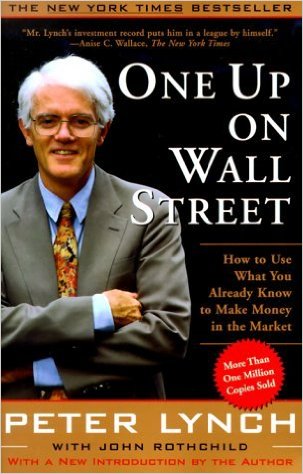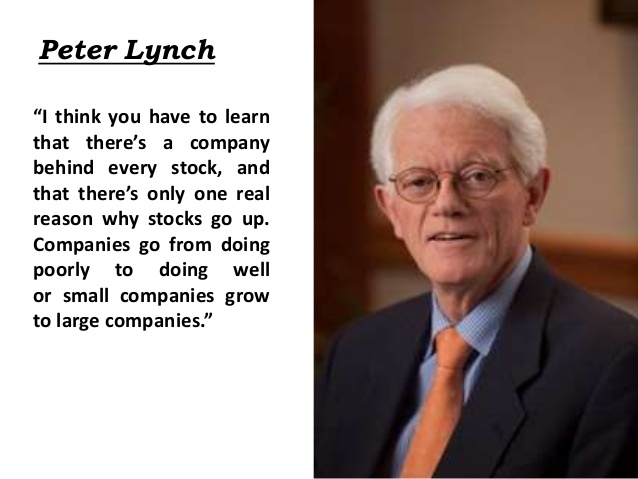
- ISBN-10: 0743200403
- ISBN-13: 978-0743200400
Buy Amazon.in
Buy Amazon.com
Peter Lynch, one of the greatest investors of our time has given ample time tested techniques in this book.
How retail investors can win in the stock market
-> Take advantage of what you already know. i.e invest in familiar sectors.
-> Invest in a house before you invest in a stock market
-> Ignore short term fluctations
-> Predicting economy or stock market direction is futile
-> 6/10 wins is a stellar record
Types of Stocks
- Slow Growers – 4 – 6% growth. Stable Business like Power and other Utilities. Buy when you can’t find anything else.
- Stalwarts – Medium Growth. 10- 12% growth. Established companies like HUL, CocaCola, P&G etc that grow year on year and make standard profit. Take profits at 30 – 50% and repeat with other stalwarts.
- Fast Growers – Medium to small size companies that grow at 20 – 25%. Assess growth phase and sustainability.
- Cyclical – Expands and contracts over time. Eg: Auto, Airlines, Tyres, steel, Chemicals.
- Turnarounds – Stay with bad news for a possible good turnaround. But stay away from tragedies where outcome is unmeasurable. Lynch considers companies moving into unrelated fields as ‘diworsification‘
- Asset Plays – Properties i.e land and other assets held by a company is more valuable than the quoted price.
Categorise the stocks you purchase into the above buckets and arrive at target price based on the category it falls.

What is a Perfect Stock?
- Dull or simple business with a boring name
- It does something dull Eg: Packaged Foods like biscuits, soap etc
- It does something disagreeable Eg: Harpic
- It’s a spinoff from a well known holding company Eg: Bajaj Finance
- Institutions don’t own and analysts don’t follow.
- Rumours abound like toxicity, mafia Eg: Casino
- There’s something depressing about the business Eg: Funeral homes
- It’s a no growth industry. Steady business, reliable customer base.
- It’s got a niche
- People have to keep buying it. Eg: Razor blades, cigarrets
- It’s a user of technology which results in massive cost savings.
- The insiders are buying
- Company is buying back shares
Which stocks to Avoid ?
-> Hottest stock in the hottest sector
-> The next something
-> Avoid ‘Diworsification’ i.e companies that expand into unrelated business
-> Avoid acquisitions that lack synergy
-> Avoid whisper stocks i.e great stories with no substance and no earnings
-> Too dependent on a handful of clients
-> Beware of stock with an exciting name
When to Buy ?
Buy when Price line is below Earnings line and Sell when Price line goes way above the earnings line.
P/ E guideline – check historic P/E levels to know average.
Utility/slow growers – 7 – 9
Stalwart – 10 – 14
Fast growth 14-20
Check if companies have a plan on how to increase future earnings – reduce costs, raise prices, expand into new markets, sell more to same market, close down loss making operations etc.
What to look for before you buy
(1) Does this new trending product have an impact on co’s prospect. If yes consider, else no.
(2) PE Ratio & Growth = long term growth rate + dividend yield / P/E Ratio – ratio < 1 poor, 1.5 – 2 – Ok , 3 and above – Excellent. This is not same as PEG ratio.
(3) Cash Position – Cash, Cash equivalents and marketable securities over long term debt. Revised P/E = Market Price (less) Cash Per Share/ Earnings
(4) Debt Factor esp for companies in trouble. Can they survive the crisis?
(5) Dividends – Regualr dividends payouts acts as floor for drop in price.
(6) Book Value (BV) – Before buying for Book Value examine the assets that form part of BV and ensure it is worthy. BV could also be Asset plays due to nderstaed value of real estate,land, securities, tax write offs etc
(7) Cash flow – Free cash flow to be checked for heavy capex industries
Signs to look out for – Piling up of (obsolete) inventory , pension plans and future obligations including contingencies. Eg: litigations.
A 20 PE at 20% growth rate will make more than 10 PE stock at 10% growth rate
Recheck your story every few months to see if they are still relevant.
How to avoid the ‘dotcom’ crash scenarios yet participate in the upside of new technology
Pick and Shovels Strategy : Investing in Denims rather than the gold rush. More money is to be made by the suppliers or direct beneficiaries of a much hyped industry Eg: Microsoft Vs Dell
Through Holding Company: When a holding company has a subsidiary in the much hyped sector which might later be spun off. Holding co. business is a downside protection.
Through ‘Brick and Mortars’ that benefit from the efficiency by use of this new technology.
Personal preferences can be a reason to add companies to list of stocks to research . But never invest without doing the homework i.e knowing
(1) Company’s earning Prospects
(2) Financial Condition
(3) Competitive Position
(4) Plans for Expansion
(5) At what stage of Expansion phase is the company currently in
Invest for the the long term so that you will not be forced to liquidate for need of cash in a bear market. Only Invest what you can afford to lose without the loss having any effect in your foreseeable future.
The Final Checklist:
- P/E ratio – High or Low – Compare with similar co’s in same industry.
- % of institutional ownership – Lower the better
- Are insiders (Promoters/Directors) buying ? Company buyback?
- Are earnings growing consistently
- Strong or Weak Balance sheets i.e Debt/Equity Ratio
- Cash Position
- For Slow growers – Dividend consistency and Dividend/Earnings ratio
- For Stalwarts – Check P/E, for possible ‘diworsificcations’, growth rate, momentum and for long holding periods chk performance over prev. recessions and downturns.
- Cyclicals – Watch out for new entrants. Anticipate shrinking P/E. auto up and down cycles last for 4-5 years each. Deeper down cause higher ups.
- Fast Growers – Is PE almost equal to growth rate in earnings. Is Expansion speeding up or slowing down? Does it have room to grow ? Proven ability to expand ?
- Turnaround – Will business survive ? Liquidation Value of company. How will turnaround happen? Is Business coming back or costs being cut ?
- Asset Plays – Is there any hidden value in the assets? Is company taking on new debts ? Beware of Provisions and contingencies.
Points to note:
(1) Understand the nature of the company and specific reason for holding the stock.
(2) Categorise your stocks for right expectations
(3) Big companies small moves in prices, small companies make big moves.
(4) If consideration is based on specific product, consider impact on company
(5) Consider small proven and profitable companies
(6) Avoid hot stocks in hot industries
(7) Be suspicious of 50% growth rates
(8) Moderately fast growers in non growth industries is an ideal investment
(9) Insiders buying the stock
(10) Don’t buy only on stated Book Value. Consider Real Value.
Realistic Expectations – six of 10 ideas and 12- 15% return.
Portfolio Allocation
A small portfolio of 3 – 10 stocks would be a managable size. The composition of the portfolio should be
Growth – 30 – 40% – Slow -Low Risk low gain /Fast – High risk high gain
Stalwarts – 10 – 20% – low risk moderate gains
Cyclicals – 10 – 20% – low risk high gains or high risk low gains based on entry level
Turnarounds – Rest – high Risk High Gain
Consider risk portfolio and age factor while allocation.
When to Sell
If company has gone up well to factor in all good news, it may be sold. But if original story is intact stay invested.
Slow Growth – On 30 – 50% appreciation or when fundamentals have deteriorated.
Stalwarts – Price strays too far from earnings, and/or industry P/E. Slowing growth or vulnerability of a major division.
Cyclical – 100% of capacity is used, Inventory build up, product slowdown, union demands, high capital requirement for expansion.
Fast Growers – too much media attention, no where to expand business, high P/E of 30 + when growth is below 20, high institutional holding, exit of key executives to join rival.
Turnaround – After the turnaround, High dependency on one customer, growing debt , rising inventory , High P/E.
Asset Plays– Once hidden value is unlocked and is fairly priced. Increased institutional ownership, lower sales, increase in debt , dilution of share value.
Do not buy a mediocre company because it is cheap.
Happy Investing. Stay Profitable 🙂

We know you love books. We would you like to give two FREE audio books. Grab your trial Audible Membership with Two Free Audio Books . Cancel at anytime and retain your books.